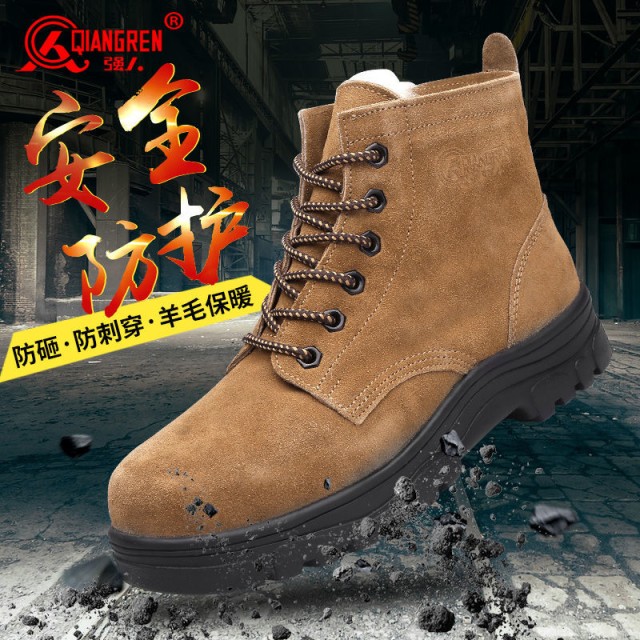When temperatures plummet below freezing, standard safety boots become inadequate. Workers in construction, oil rigs, and utilities need footwear that combines impact protection with advanced thermal regulation—without compromising mobility. This guide decodes the science behind toe materials, insulation synergy, and industry-specific certifications to help you select boots that outperform in extreme cold.
Cold Weather Boot Performance Fundamentals
Thermal Dynamics of Toe Materials
Steel toes dominate heavy-impact scenarios but suffer critical drawbacks in sub-zero environments:
- Conductive Heat Loss: Metal rapidly absorbs body heat, increasing frostbite risk.
- Weight Penalty: Additional energy expenditure accelerates fatigue in cold climates.
Composite toes (carbon fiber, Kevlar) address these issues with:
- Thermal Insulation: Non-metallic materials retain warmth 30–50% more effectively.
- Lightweight Design: Reduced bulk improves mobility—critical for ladder work or icy surfaces.
Key Trade-off: While composites meet ASTM impact standards, they require thicker designs to match steel’s 15kN crush resistance.
Insulation Synergy with Safety Components
Effective cold-weather boots integrate insulation around safety features:
- Moisture-Wicking Liners: Prevent sweat accumulation—a major cause of heat loss.
- Aerogel Barriers: Ultra-thin materials like PrimaLoft® reflect body heat without adding bulk.
- Breathable Membranes: Gore-Tex® or similar layers block wind while releasing vapor.
Pro Tip: Look for boots combining composite toes with 200–400g Thinsulate™—this balances warmth and dexterity for most winter worksites.
Practical Application Guide
Construction vs. Oil Rig Winter Requirements
| Factor | Construction Sites | Offshore Oil Rigs |
|---|---|---|
| Primary Hazard | Falling tools | Slippery metal surfaces |
| Temperature Range | -20°F to 32°F | -40°F to 14°F |
| Boot Recommendation | Steel toe + Vibram® sole | Composite toe + spiked outsole |
Why It Matters: Oil rig workers prioritize slip resistance over pure impact protection—steel toes become liability on icy platforms.
Extreme Cold Certification Standards
ASTM F2413-18 mandates:
- Impact Resistance: Toe caps must withstand 75 ft-lbs force.
- Compression Tests: 2,500 lbs minimum load capacity.
- Electrical Hazard (EH) Rating: Critical for utility workers.
Beyond Compliance: Boots labeled for "Extreme Conditions" often include:
- Metatarsal guards to shield foot tops from falling ice.
- Reflective strips for low-visibility environments.
Optimization Strategies
Layering Systems with Safety Toes
- Base Layer: Moisture-wicking sock liners (avoid cotton—it traps sweat).
- Mid Layer: Insulated boot liner with removable heat packs.
- Outer Shell: Waterproof membrane bonded to composite toe box.
Field Tested: Workers in Alaskan pipelines report 20% longer shift endurance using this system versus single-layer insulated boots.
Maintenance for Sustained Thermal Performance
- Weekly Cleaning: Salt residues degrade waterproof seals. Use pH-neutral cleaners.
- Conditioning: Silicone-based treatments preserve leather flexibility in dry cold.
- Storage: Keep boots in climate-controlled areas—repeated freeze-thaw cycles crack soles.
Stay Protected with 3515’s Winter-Ready Safety Solutions
3515 equips distributors and bulk buyers with rigorously tested cold-weather boots engineered for:
- Distributors: High-margin inventory with certifications appealing to safety managers.
- Brand Owners: Customizable designs matching regional cold-weather demands.
Ready to upgrade your winter footwear lineup? Partner with 3515 to source boots that blend uncompromising safety with advanced thermal tech—because frozen toes shouldn’t be part of the job description.
Related Products
- Wholesale Customizable Safety Boots Durable & Protective Footwear Manufacturing
- Wholesale Safety Footwear Manufacturer for Bulk & Custom OEM Orders
- Customizable Anti-Smash Safety Boots for Wholesale & Private Label Manufacturing
- Durable Mid-Cut Tactical Boots for Wholesale & Private Label
- Durable Leather Safety Boots for Wholesale & Custom OEM Manufacturing
Related Articles
- How to Choose Steel Toe Boots: Safety, Comfort, and Job-Specific Features
- How to Choose Between Steel and Composite Toe Boots for Maximum Safety
- Steel Toe Boots vs. Modern Alternatives: Making the Right Safety Choice
- Matching Men’s Work Shoe Safety Technologies to Workplace Hazards
- How to Prevent Foot Injuries from Steel Toe Boots Without Sacrificing Safety



















